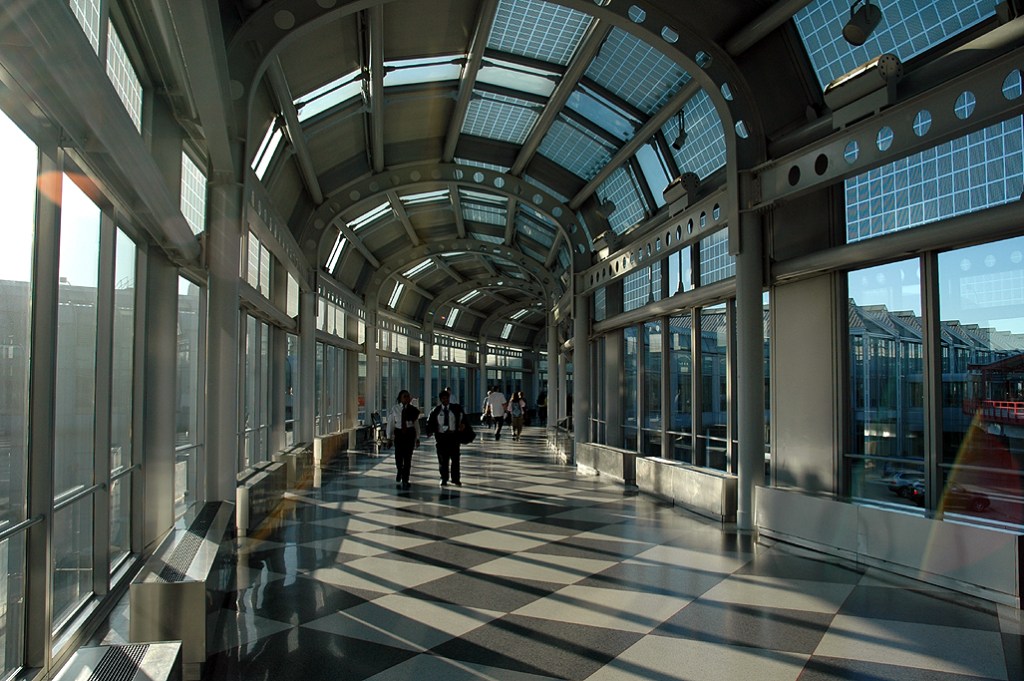Landing in Chicago for the Biennial I wrote about last week, I taxied to the United terminal at O’Hare and thought how radical it still looks after all these years. I remember first seeing it assemble itself seemingly autonomously as a skeleton out of a sea of asphalt, and then coalescing into ripples of colored glass. It still looks fresh, even weird. In the three decades since the bifurcated structure designed by Helmut Jahn, FAIA (of Chicago-based Jahn, formerly Murphy/Jahn), we have seen airports swooping and swerving across the world. By now, they all look or less the same: Good, bad, or so-so versions of Norman Foster, FAIA’s 1998 Chep Lak Kok Airport in Hong Kong. Not the United terminal.
What I love most about the building is that it always looks like a fragment. Not only does it consist of a landside and a midfield terminal connected underground, but the two pieces have no clear hierarchy or rhythm, just the asymmetrical arches that hold up the striped glass container and define the interior space. The terminals bulge and undulate to accommodate waiting areas and jet ways, and the whole landside part curves to meet the approach roads. The structure is clunky and cut-off, and reminds me more of what you see when an airplane’s flaps extend and retract during takeoff and landing then of either the plane itself or that cliché of airport design, birds. It reflects the reality of flying, not the ideal.
Truth be told, the place is a bit run-down and cramped. It could use an update that acknowledges how we move (or don’t) through airports today. But at least you know where you are when you are there.
The same is true of another building Helmut Jahn designed at the same time as the United terminal: The James R. Thompson Center in the Loop. Another fragment of a building, the Center curves its way out of the Chicago grid with a cascade of glass spilling over floors where over two thousand bureaucrats toil. At its center is a retail atrium surmounted by a diagonal skylight. Like the O’Hare building, this is a deconstruction of its type, fragmenting the bureaucratic block as well as the dome of democracy that marks our shared government.
While the United terminal is, as far as I know, in no danger of being torn down, the Thompson Center is. Illinois Governor Bruce Rauner announced this week that he wants to sell the building “as soon as possible” and for as much money as possible—which means he wants no restrictions on what a buyer could do with the building or the site. That is the Center’s death sentence: The current building is too low and leaves way too much public space unbuilt to maximize the lot’s potential, and, after years of deferred maintenance, the Thompson Center needs too much money to bring it up to today’s standards.
Losing the Thompson Center would be not only a shame, but also a mark of how we are unwilling to invest in our public infrastructure on every level. I would hope that, at a minimum, the Governor could be persuaded to prevent its complete demolition. The last thing Chicago needs is another cookie-cutter office building or condo tower on the site.
Neither the Thompson Center nor the United terminal is beautiful in either the classical or the modernist sense. They are raw, jaunty, and very much present. Their architecture neither recedes nor tells you what is right, but instead makes you find your own way and make up your own mind. You could even see these buildings as precursors for the kind of experimentation to which the Chicago Architecture Biennial has dedicated itself. Perhaps the powers that brought that celebration of Chicago’s past, present, and possible future into being can ensure these hard-working relics’ survival as well.
